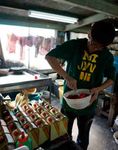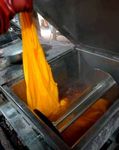Hand- Dyed in Tokyo Sumida Textiles, Tokyo - some-zome
←
→
Page content transcription
If your browser does not render page correctly, please read the page content below
Mottled turquoise pattern
Hand-
Dyed in
Tokyo Kiriko cut-glass print and
gradation dye combination
Sumida Textiles, Tokyo
With its network of natural and man-made waterways, Tokyo has been an
ideal place for fabric dyeing since the earliest days of the capital. In the
Edo era (1603–1868) it was common to see long bolts of kimono fabric
rippling in the waters as craftsmen washed the dyed cloth. Although the
methods have changed, in modern-day Tokyo the industry remains strong.
8Lattice print and gradation
dye combination
Three-layer tie-dyed
circle motif
Mottled coral dye pattern
Brushed dye pattern
Random spray dye pattern
Blue to orange multicolored 9
gradationCountless colors on demand
Edo murasaki is a shade of purple with a slight blue changes again. These concerns make colorant blend-
tint. Theater aficionados in Japan know it as the color ing a complex task indeed, as dyers need to account
of the cloth wrapped around the head of Sukeroku, the for subtle changes that occur when the fabric is
lead character in the popular Kabuki play of the same washed to set the dyes. A neutral gray or beige, in
name. It is one of many hues that can truly be called a which the three primary colors must be evenly bal-
traditional Tokyo color. But what colors could possibly anced, will turn pink if there is too much red, or ap-
characterize the Tokyo of today—a teeming metropo- pear green if there is too much blue.
lis and cosmopolitan mishmash of fashion that glit- And so the mother lode of past data, as well as the
ters with a vast palette of hues and tints? A number of artisan’s skill in measuring and mixing, is essential to
hand-dyeing shops are striving to recreate that full rendering any given color. While some shops, like
spectrum, producing colors with remarkable accura- Uchida Dyeing Works, use computers and spectropho-
cy and speed. tometers for efficiency measuring and mixing pig-
Place an order with a swatch or color chip, and the ments to within 0.0001 percent of a kilogram, in the
shop will delve into a formidable databank of colors end the final product depends on the eyes of the peo-
amassed over the history of the craft to instantly dye ple guiding the process. As any dyer will tell you, “We
your fabric to the exact color of the sample. It’s even know what to do as soon as we see the color sample.”
possible for a client to send undyed fabric and a color Hand dyeing also makes it possible to fill small-lot
sample by courier and receive the dyed cloth on the custom orders for 10 to 20 items, a task the larger
same day. In Tokyo’s concentrated apparel industry, factories with batteries of dyeing machines are un-
where exhibitions open and close constantly, this is able to do. Uchida Dyeing Works employs a dozen or
an invaluable service. so craftsmen, each responsible for five to six dyeing
In fabric dyeing the mixing and matching of color vats that can rotate between orders twice daily.
draws on the three primary colors red, yellow, and Though small in size, the studio can dye more than
blue—except for special cases like emerald green, for 100 different items in a single day.
example, which is rendered by blending a vivid blue- Buyers in Japan are unforgiving when colors fade
tinged yellow with turquoise blue. The complexities before their time—or, worse, bleed—as that is considered
multiply exponentially from there. Even the same dye low-quality workmanship. With small-batch hand-dyeing
will look different when applied to different kinds of of original or one-of-a-kind items, the pressure is espe-
fabrics, and apparel makers today often mix fabrics cially high to yield exactly the right result. Nevertheless,
and textures in the same article of clothing. Once a Sumida’s seasoned craftsmen settle into their task mat-
fabric is washed after dyeing, the look of its color ter-of-factly, turning out an endless spectrum of colors.
10Above: The seamless gradation of one color
blending into another is only possible with
hand dyeing.
Left: Computers are used to calculate color
blends, drawing from a vast database of
combinations amassed over decades.
Below: Just one portion of color samples that
cover the full range of hues available.
Photos: Uchida Dyeing Works
11Sumida craftsmen show off their own “some-zome” brand T-shirts, designed by Yumika Shiraki and featuring Edo-inspired tie-dye, print, and gradation themes. 12
A prominent new symbol of the city, Tokyo
Skytree is lit up in a shifting kaleidoscope of
traditional Edo-period colors.
13A trio of hand-dyeing
specialists
Perhaps a brief explanation of what is meant by turned upside-down. It’s harder than it sounds—only three
“hand-dyeing” is needed. In the olden days, fabric was dyers in the shop have mastered the technique. The colors
dyed over fire in iron vats, the cloth and dye bath churned flow naturally, one shade blending into the next in a way that
by hand. While today’s factories are equipped with pad- no machine can achieve.
dle-dyeing machines, the only difference is that the agi- These three shops, in collaboration with the Tokyo Tex-
tation once done by hand is now performed by rotating tile Dyeing and Printing Cooperative, have united their re-
blades. The overall process, starting with the blending of spective areas of expertise to launch a new Tokyo brand of
the pigments, remains very much a hands-on process. hand-dyed textiles under the “some-zome” name.
Kawai Dyeing Works uses a proprietary dyeing tech-
nique called azumadaki that can give soft appeal to even
the coarsest of linen fabrics, yielding a look that no ma-
chine can match. The adjustments required for different
materials and types of weave are far too complex and
delicate to be processed by machine; what’s more, most
continuous dyeing machines are designed for bolts of
500 meters or longer. Kawai’s method introduces cloth
to the dyeing vats in lengths of 100 to 200 meters, making
small-batch orders possible. Dyeing a 1,000-meter bolt
of fabric requires the process to be repeated at least five
times, but the company has successfully applied this
technique to as many as 71 different kinds of fabrics and
weaves. Above: Brush dyeing (blue) and tie-dyeing (black) are brought together in
the bold design of this shirt. When colors and textures are combined this
Kuronuma Dyeing receives a steady stream of re- way, employing diverse dyeing and washing techniques as well as
quests for its silk-screened customized hoodies, T-shirts, different dyes and pigments, the possible expressions are limitless.
and other apparel, turning around nonstop orders for as
Opposite page, top left: Silk-screen printing is done by hand, one print
few as ten to several hundred. Each item is hand-printed, at a time. (Kuronuma Dyeing)
even for designs requiring as many as ten different pig- Top right: Gradation dyeing is a task for the most experienced. (Uchida
Dyeing Works)
ments. The shop is also adept at designs that combine Middle left: Even with all the available data, color adjustments are
print and dye methods in a single piece of clothing. made by an experienced craftsman. (Kuronuma Dyeing)
Middle right: Dye pigments are weighed to an accuracy of three decimal
Uchida Dyeing Works specializes in gradation dyeing. places. (Kawai Dyeing Works)
Batches of 30 to 40 articles at a time are suspended over the Bottom left: Each randomly bleached item will have its own unique
pattern. (Kuronuma Dyeing)
dye bath and repeatedly dipped to varying degrees to yield a Bottom right: The paddle-dyeing machine works as an extension of
delicate, seamless effect. At times the articles may even be human hands, ensuring even coloration. (Kawai Dyeing Works)
14You can also read



























































